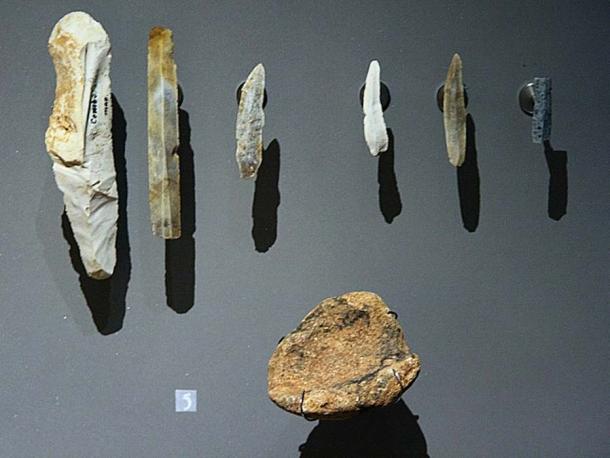Surprising Stone Age Knowledge Revealed on a Mammoth Bone Bracelet
In Sivershchina, close to the village of Mizyn in Ukraine is one of the oldest and most unique settlements of humans – and it was discovered in a parking lot. The now well-known archaeological site, known plainly as the Mizyn parking lot, dates back 18-20 thousand years. In this spot two intricately carved bracelets made from mammoth bone were found, which led to the unraveling of a fantastic Stone Age discovery.
Investigating the settlement
The beginning of the research at this site dates back to the early twentieth century, in the summer of 1908, in the neighboring village of Psarivka (today about Desniansk). Archaeologist Fedir Vovk with his disciple Sergii Rudenko hired a farmstead for a summer holiday. In the nearby forest he found a small flint of obviously deliberate splitting. It prompted the scientist to investigate the situation on the spot and he was able to identify the find as from “the Paleolithic station of the late Paleolithic of the Madeline era”.

Artists impression of the settlement at Mysinskaya parking. (Image: Yuriy Yezhakevich. Encyclopedia of Ukraine)
Vovk presented a report of the findings during the congress of archaeologists later that year. In addition, as part of the exhibit he displayed 72 animal bones and several small showcases of flint tools. With these clues pointing towards ancient activity in the area, the excavations that he had begun in 1908 were continued under the direction of Vovk, and in 1909, his students P. Efimenko and V. Sakharov.

A selection of similar period prehistoric tools for illustration. (CC BY-SA 4.0)
Human settlers
One of the most characteristic features of the habitation that the archaeologists found at the Mizyna parking lot were five round dwellings, each with a diameter of about seven meters (23 ft) and an area of up to 25 square meters (270 sq ft).
- Archaeologists unearth 6,000-Year-Old Temple in Ukraine
- An ancient map is found in Ukraine
- The Origin of Lunar New Year and the Legend of Nian

Reconstruction of Paleolithic housing in Mizyn. Source: Encyclopedia of Ukraine (Author provided)
These dome-like dwellings incorporated mammoth bones in their construction and resembled the "plague" of the northern peoples: they were built of wooden poles, covered with animal skins, and externally lined with animal bones and horns. Nearby there were places for processing stone and bones.
In addition to residential and commercial buildings in this area, many original high-art products from the mammoth tusk have been found: sculpture-idols, stylized female figurines, animal figures, birds, intricately engraved mammoth bones, the world's first musical instruments ensemble, and bracelets with perhaps the world's first ornament.
It is not known how the bracelets were made and in particular how they were bent using the limited technology available 18 thousand years ago.
The designs on the bracelet were made with deep engraving and a red dye on flat plates of the mammoth's tusk.

Bracelet from Mizyn. Image: Encyclopedia of Ukraine (Author provided)
An Ancient Calendar
Studying the bracelet, the Soviet historian Boris Frolov drew attention to the fact that the decorations of bracelets have five zones, three of which are made of a meandering in the form of a swastika, and two - zigzags. Studying the first three zones in which there were 30 meanders, which in turn consisted of 12 lines, the researcher drew attention to Ancient Egypt, where the calendar was created by Egyptian priests in the IV millennium BC, had 360 days a year, and compiled from 12 months. Later, they began to add 5 extra days that were not included in any month and devoted to the memory of the deceased. Based on this, he suggested that 30 meanders mean the days of the month, while 12 lines are the months themselves. And multiplying 30 by 12, the result is 360, that is, the ancient Egyptian year. From this, we can assume that the Egyptian calendar could have begun in the Stone Age.
Subsequently, the researcher focused in the two zones which consist of zigzag lines. In the first zone - 6 zigzags on 7 lines in each, therefore 42 lines. In the second zone - 8 zigzags on 7 lines, only 56 lines. And in general - 14 zigzags, 98 lines. Frolov knew that in the archaic lunar calendar of the people of Chukchi, living in the far east of Asia, there were 14 weeks for 7 days, a total of 98 days.
- Mauritius Square, Ukraine: What is this Giant Crab-like Earthworks?
- Unique 5,000-Year-Old Tomb from Ukraine Brought to Light with Digital Reconstruction
- The Oldest Known Calendar in Europe is based on the Orion Constellation

A Chukchi family in front of their home near the Bering strait. Drawing by Louis Choris in summer 1816. (Public Domain)
Thus, before the researcher emerged the ancient lunar-solar calendar. You can imagine the surprise to other scholars when they found out that the bracelet is an ancient calendar!
Another ancient calendar
However, this is not the only Paleolithic complex where the oldest calendar was found. In 1871 a Paleolithic station was found between the villages of Dukhov and Ginci (now Lubensky district of the Poltava region), excavations of which began in 1873 by the Lubsky archaeologist and teacher F. I. Kaminsky.

Paleolithic parking in the village of Ginci. Modern look. (CC BY-SA 4.0)
All the attention to this parking lot attracted academician Vladimir Vernadsky. As the researcher of the antiquity of Poltava Oleksandr Suprunenko, V. Vernadsky began researching the monument in 1915. During the expedition of the Natural History Museum of the Poltava Province, excavation was granted of one of the dwellings of Ginci late Paleolithic stables, organized by V. M. Shcherbakivsky which produced ancient materials.
The excavations of the Ginci parking are carried out to this day, and the most valuable find, which was found there is an engraved tusk of a mammoth aged 10-15 thousand years. On the basis of studies by the American historian and archaeologist Alexander Marshak, it was found that the alternation of long and short marks on tusks is a lunar calendar which reflects the observation of the primitive man in the phases of the moon.
Unfortunately, at a key moment, the artifact was lost. One version of the reason for this is the monument was destroyed by the fire that arose after a bomb attack during the Second World War. According to another version, the artifact was destroyed even earlier, during the citizens-war of 1918-1920, or exported abroad for preservation in 1922, when the researcher of the aforementioned parking lot, V. Shcherbakivsky emigrated to Prague.
Historians and archaeologists still cannot understand why the original hunters have a calendar, and how they knew the exact time of the phases of the moon and the period of rotation of the Earth around the Sun, which is equivalent to a year. But this riddle remains to be solved.
Top image: Mammoth in the Royal BC Museum in Victoria (Canada). The display is from 1979, and the fur is musk ox hair. (CC BY-SA 2.0)
By Ingvar nord
Resources:
Shovkoplyas T. From the history of the study of the Mysina parking lot // Siveriansky Chronicle. - Chernihiv, 2008. - No. 6. - P. 23. (in Ukrainian)
Drozd S. Miyznaya parking - the most famous parking lot of the Paleolithic age. – Available at: http://starozytnosti.blogspot.com/2013/02/blog-post_868.html (in Ukrainian)
Biletskiy O. Mizinskiy Brahlings with Swargamy. – Available at: http://biletskyi.blogspot.com/2010/12/18000.html (in Ukrainian)
Bracelets of Mizyn - the oldest calendar. – Available at: http://www.aratta-ukraine.com/text_ua.php?id=204 (in Ukrainian)
Paleolithic Parking of Ginci. – Available at: http://www.spadok.org.ua/stoyanky/gintsivska-paleolitychna-stoyanka (in Ukrainian)
Suprunenko O. B. VI I. Vernadsky and archeology of Poltava region // Sumy antiquity. - Sumy. 2013. - № 40. - С.110. (in Ukrainian)


















Comments
All possible utility-functions for any ancient implement, be they so-called ‘bracelets’ or whatever, should be completely exhausted before concluding they were produced for ornamental purposes. Only when NOTHING is needed does the ‘mother of invention’ lay idle, and the mind can explore wearable follies.
Nobody gets paid to tell the truth.
Great suggestion Rayna!
Ahem, not to point out the obvious but while stone age man might not have needed to keep track of moon cycles, stone age WOMAN certainly would have had good reason to want know if her period was due, or was late.
Not a riddle, just blinkered thinking.